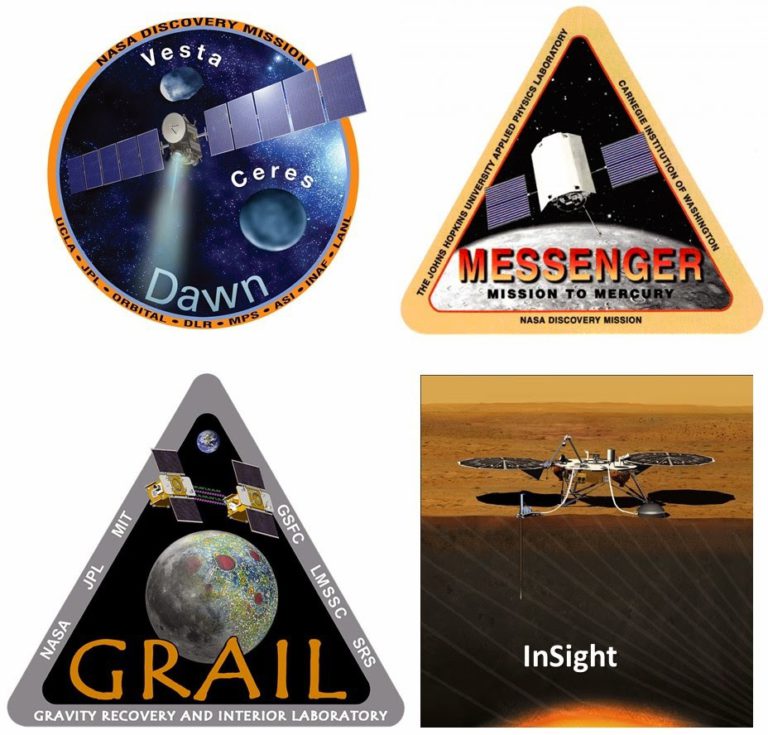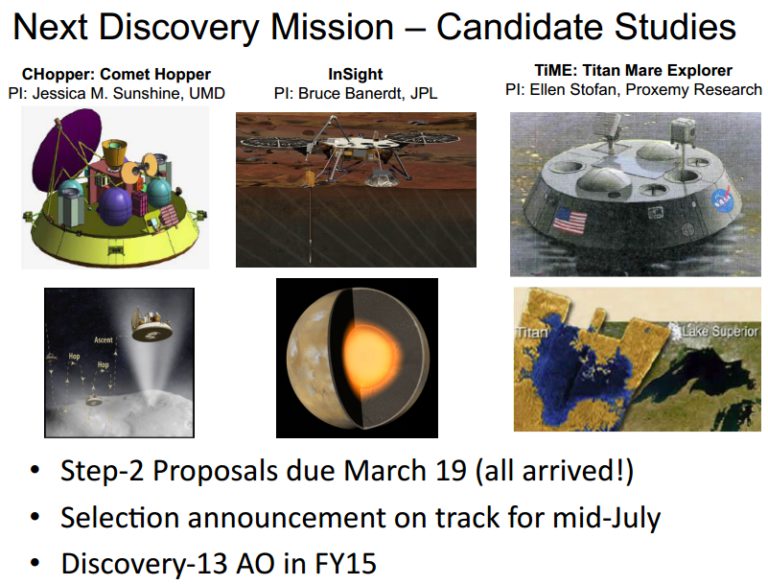Van Kane • Dec 01, 2014
Selecting the Next Creative Idea for Exploring the Solar System
With the release of the official Announcement of Opportunity (AO) early in November, NASA has officially begun the competition to select its next low cost ($450M) Discovery program planetary mission. Because planetary scientists are free to propose missions to any destination in the solar system other than the sun and Earth, these competitions bring out the creativity in the planetary science program. Will we get a Venus orbiter? A return to the Mars polar regions? A comet lander? An orbiter around the exposed core of a protoplanet? Flybys of Jupiter’s moon Io? These are just the start of the list of missions likely to be proposed.

The breadth of possibilities for these small missions is in contrast to that for NASA’s larger planetary missions. For its mid-cost ($700M to $800M) New Frontiers missions, scientists only can propose missions from a list of around five high priority missions identified once every ten years in the Decadal Survey. Targets for NASA’s largest missions (>$1.5B), the Flagships like Cassini at Saturn, also are chosen from an even shorter list approved in the Decadal Surveys.
Practicalities will limit the ambitions of the Discovery proposals, though. Foremost among these is the tight cost cap, $450M. This is just a little more than half the funds available to New Frontiers missions such as the OSIRIS-REx asteroid sample return mission that is in development. The Discovery cost cap also is less than a fifth the cost of the Flagship Curiosity rover that is on Mars or a quarter the cost of the proposed Europa Clipper mission.
Missions also will need to depend on solar power. In the future, NASA hopes to make radioisotope (plutonium-238) power systems available for Discovery missions, which would open up missions to the far outer solar system or the permanently shadowed lunar craters among other destinations. For the current selection, however, NASA cannot build a radioisotope system in time, with the result that the chosen mission will need to depend on solar cells. This limits the next mission to go no further from the sun than Jupiter. (For an article on the status of NASA’s plutonium-238 program, check out this article from the journal Nature.)
A long string of low-cost planetary missions (less than ~$500M) from NASA over the last twenty years shows that a wide variety of missions can be flown within these constraints:
1996: NEAR – near Earth asteroid rendezvous and landing
1996: Pathfinder – Mars lander and rover
1998: Lunar Prospector - orbiter
1999: Stardust comet sample return and 2 comet flybys
2001: Genesis – returned samples of the solar wind
2002: CONTOUR – multiple comet flybys (failed)
2004: MESSENGER – Mercury orbiter
2005: Deep Impact – Delivered impactor to comet & 2 comet flybys
2007: *Phoenix – Mars polar lander
2007: Dawn – orbit asteroids Vesta and Ceres
2009: Kepler – exoplanet hunter
2009: *Lunar Reconnaissance Orbiter
2011: GRAIL – 2 lunar orbiters
2013: *MAVEN – Mars orbiter
2013: *LADEE Lunar orbiter
2016: InSight – Mars geophysical station
2021: Latest launch for the next mission
Launch dates shown. *Selected under NASA’s low cost lunar or Mars program
Based on the NASA’s last competition, the planetary science community hasn’t run out of ideas. An informal tally of proposals (NASA doesn’t release information on proposals not selected as finalists) included seven Venus, three lunar, four Martian or Martian moon, eight asteroid, three comet, one Io, and two Titan proposals. (The previous competition had an option for a radioisotope power system that enabled several of the proposals.) Most teams don’t discuss their proposal ideas (this is a highly competitive business), but so far for this latest competition I’m aware of proposals for Venus missions, a Martian polar lander (IceBreaker), a spacecraft to study Mars’ two moons (PADME), and a mission to the asteroid Psyche that would explore the core of a protoplanet.
Next June, NASA’s managers will announce a list of finalists for the current competition, and we will see which proposals the agency’s reviewers believe have the best combination of scientific merit and feasibility. These teams then will have approximately a year to prepare more detailed proposals (Phase A studies) followed by NASA’s announcement of the final winner in September 2016. The selected mission must launch by the end of 2021.
During its first decade of this program, NASA’s Discovery program selected missions approximately every two years. The next decade saw just two missions selected as NASA’s budgets tightened and it had to pay for the development of other missions. Based on the latest proposed NASA budget (for Fiscal Year 2015, which has yet to be approved by Congress), NASA would return to selecting Discovery missions more frequently, perhaps every two to three years. The higher flight rate for Discovery missions would come at a cost, however. The NASA budget does not include proposed funding for additional New Frontiers missions, ruling out more challenging missions such as landing on Venus or returning samples from the moon or from a comet.
For the last two Discovery mission selections, a number of scientists have felt that NASA was overly conservative, selecting the safest rather than the scientifically most compelling mission from the finalists. (See, for example, this article from the journal Nature.) In the last selection, for example, NASA passed over its last chance to do an inexpensive landing on of the lakes of Saturn’s moon Titan for decades in favor of a Mars lander than will reuse much of the technology proven by the previous Phoenix lander. (I will hasten to say, though, that the selected Mars InSight lander will conduct excellent science; no mission makes the finalist list that wouldn’t do great science.)
As the list of these selected low cost missions has grown, many of the easiest and lowest cost ideas have already been flown. As a result, the complexity of missions has risen over time (see this blog post), making them more difficult to develop and fly within the cost cap. Several of the selected Discovery missions also suffered significant budget overruns, delaying the start of further new missions and subjecting NASA to Congressional criticisms (see this blog post). Perhaps as a result of more conservatively judging missions during their selection, cost overruns have become less common.


All competitions come with rules, and NASA’s managers have a 143 page Announcement of Opportunity that spells out the details for Discovery mission proposals. The key rules for this selection are:
- Proposals can target any solar system body except the sun and Earth. Missions also cannot study planets around other stars. (NASA has other programs to support missions for these targets.)
- The total cost for the spacecraft, instruments, and data analysis are $450M. This figure is similar to that for the competitions that led to the selections of the lunar GRAIL and Martian InSight lander missions. NASA will cover the costs of a standard launch separately (missions that require non-standard launches will have to pay for the additional costs out of their $450M budget).
- In a key change from previous Discovery competitions, NASA will separately pay for the cost of mission operations outside of the $450M budget cap. Each year of flight typically entails operations costs of around $7-10M. A five year mission to Jupiter or to a hard-to-reach comet or asteroid automatically had a ~$50M penalty compared to missions to the moon, Venus, or Mars where flight times were measured in weeks or months. This change levels the playing field.
- Planetary missions are often done as collaborations between space agencies. To fit within the tight cost cap of Discovery missions, some prior missions have had a substantial portion of their scientific payload contributed by foreign scientists and paid for their governments. NASA’s managers want to support US scientists and have set the maximum foreign contribution to no more than one-third the total cost of the total mission and one-third of cost of the scientific instruments.
- NASA has various new technologies that it would like to see demonstrated in a flight mission. It will, for example, increase the cost cap by $30M if the winning proposal uses NASA’s laser communications system, which can return far more data than radio systems. In a previous draft proposal for this Discovery competition, NASA previously had indicated that using this system might be mandatory. It is now optional. Presumably missions that would return vast amounts of data like a Venus radar mapper might use this option while a Venus atmospheric probe that would return only a small amount of data would not.
When NASA announces the finalists for this competition next spring, we’ll see new examples the creativity of the scientific community has for exploring the solar system.
Support our core enterprises
Your support powers our mission to explore worlds, find life, and defend Earth. You make all the difference when you make a gift. Give today!
Donate

 Explore Worlds
Explore Worlds Find Life
Find Life Defend Earth
Defend Earth

